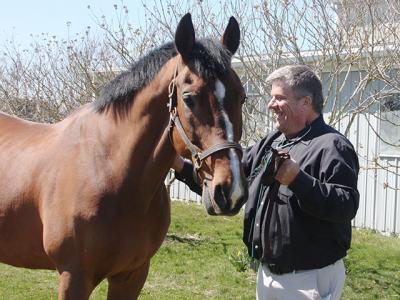As Horses Return, So Do Barn Calls

For Dr. James Meyer, a large-animal veterinarian in East Hampton, work is about to get a lot busier. Just as many residents escape the South Fork to Florida or other warmer climes in the winter, so do many of the horses that summer in the Hamptons. Soon, they will return to places like the Southampton Polo Club, private farms where polo matches are held, and many residential properties.
Dr. Meyer and his wife, Ilissa Loewenstein Meyer, own and operate Equine Sport Science, a mobile equine practice. “I have an office in my house,” he said, “but the work is done like a doctor that makes house calls. I make barn calls.” His work takes him as far as Riverhead but is primarily based between Montauk and Southampton. Patients are “pleasure horses, jumping horses, and, in the summer, a lot of polo ponies,” he said.
Dr. Meyer, the only veterinarian who is board certified in large-animal internal medicine in Suffolk County, will soon hold a new distinction: He is halfway to earning a Master of Science in medical statistics from the Centre for Evidence-Based Medicine at the University of Oxford in England.
“I had taken an interest in decision making in the biomedical field,” said Dr. Meyer, who graduated from Ontario Veterinary College at the University of Guelph in Canada, the oldest veterinary college in North America. “I was in practice for a few years working with horses, then decided to do further training, and that’s when I specialized in large-animal internal medicine.”
He received board certification at the University of Florida in Gainesville. “Essentially, you focus on almost any kind of medical issue that doesn’t involve surgery,” he said of large-animal internal medicine. “I did that, went back to practice for a while, then went to teach, though not as a full professor, at Texas A&M University” in College Station.
His interest in research led to the Centre for Evidence-Based Medicine. “Veterinary medicine frequently follows human medicine,” Dr. Meyer said. “Evidence-based medicine really came to the forefront in the 1990s. Some of the problems are that we don’t have the amount of clinical research that’s been done in human medicine. That limits it somewhat, but it’s about trying to use good research studies that have been validated, and applying it to your patients.”
“It’s being introduced,” he said of evidence-based medicine in the veterinary field, “but I would like it to be more a part of veterinary medicine. What helped it take off is the internet. With technology, you can search databases and get all this information much easier than 20 or 30 years ago.”
To earn the degree, Dr. Meyer must complete six courses, of which he has taken and passed three. This is done both onsite and remotely, he explained. “There is one week of intensive classroom work at the school for the five days you’re there, 8 to 10 hours per day,” he said. “The week prior, you get your reading material online, and for six to seven weeks after you get assignments online.” Each course requires a final exam. “To get the degree, you have to write the dissertation,” he added.
The Centre for Evidence-Based Medicine “is obviously not a veterinary school,” he said. “It’s open to anyone who does medical stuff, with physicians, nurses, dentists — there was even a midwife I met there.”
When he has earned his degree, his qualifications will be rare. At the center, “they told me there was another veterinarian who’d done the program. She worked in England at a university. But as far as I know, no other veterinarian is doing this program in the United States.”
Flexibility in scheduling allows Dr. Meyer to concentrate on his summer and fall workload. “One of the big advantages is you can do it on a part-time basis,” he said. “You can still have your career and work on this degree.” He will return to Oxford in December.
Until then, the imminent arrival of equine summer visitors will keep him occupied. Along with routine vaccinations, South Fork horses tend to experience maladies of the musculoskeletal or gastrointestinal variety, he said. “The horse’s value to a lot of people is in their ability to move, so limb problems is problem number one. Number two is colic, which is a general term for a painful abdomen.”
A few disorders, while not unique to the South Fork, are more common here, he said, such as tick-borne Lyme disease and anaplasmosis. Another is endocrine laminitis, which Dr. Meyer likened to Type 2 diabetes, affecting the feet and potentially leading to an inability to walk. “The pastures are so lush here,” Dr. Meyer said, “and the animals are so well taken care of they can get overweight. It’s not only occurring here, but anecdotally I see it in higher numbers than anywhere else.”
Between his work and his continuing education, there is no shortage of stimulation, the doctor observed. “Any job can get routine. But when I was living in Florida, a student from the Dominican Republic came to travel with me. He was a small-animal veterinarian but needed experience with large animals to get his license. He said, ‘You’re very lucky to spend the day with these regal animals.’ I should remember that.”
